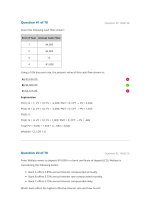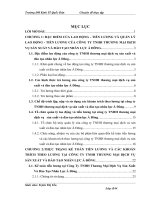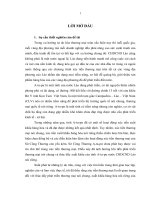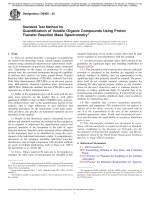Solution manual of environmental chemistry a global perspective 4th ch04
Bạn đang xem bản rút gọn của tài liệu. Xem và tải ngay bản đầy đủ của tài liệu tại đây (230.57 KB, 9 trang )
Solutions: Environmental Chemistry - a global perspective 4th Edition
Chapter 4:
Tropospheric chemistry – smog
PROBLEMS/SOLUTIONS
1. A general formula for gasoline is C7H13. Calculate the air to gasoline mass ratio required for
stoichiometric combustion.
Solution
C7H13 +
O2
4 C7H13 + 41 O2
→
CO2 +
H2O
→ 28 CO2 + 26 H2O
(unbalanced)
(balanced)
mass of gasoline:
M.M. of C7H13 = 97.18 g mol-1
[ multiply by 4 mol ]
= 389 g of gasoline [ which reacts with 41 mol of O2 ]
mass of O2:
M.M. of O2
=
32.0 g mol-1
= 1312 g of O2
[ multiply by 41 mol ]
[ therefore the O2 : gasoline mass ratio = 3.4 : 1]
1 mole of air contains:
0.78 mol x 28 g mol-1
0.21 mol x 32 g mol-1
0.01 mol x 40 g mol-1
= 21.84 g N2
= 6.72 g O2
= 0.40 g Ar
-------total mass = 28.96 g
fraction of oxygen in air by mass
6.72 g ÷ 28.96 g = 0.232
Air is 23.2% O2 by mass. Therefore the mass of air required is calculated from the mass of oxygen
required:
1312 g (O2) ÷ 0.232 g (O2) / 1 g (air) = 5655 g (air)
mass ratio of
air : gasoline
is
5655 g : 389 g = 14.5 : 1
The air to gasoline mass ratio for stiochiometric combustion is 14.5:1.
A second way of calculating this ratio would be to use the mole fraction of 0.21 for O 2 and calculate the
moles of air.
41 moles of O2 ÷ 0.21 (fraction of O2) = 195.2 moles of air
Air has a M.M. of 28.96 g mol-1 which gives 195.2 mol x 28.96 g mol-1 = 5654 g of air, and a mass ratio
(air to O2) of 5654 g : 389 g = 14.6 : 1 (the same as above).
2. Write out a general sequence for the photochemical oxidation of butane.
Solution
The sequence below starts with the photochemical production of the hydroxyl radical from ozone.
O3 + hν → O* (1D) + O2* (1Δg)
24
Solutions: Environmental Chemistry - a global perspective 4th Edition
Chapter 4:
Tropospheric chemistry – smog
O* (1D) + H2O → 2 •OH
The hydroxyl radical will abstract a proton from butane to form an alkyl radical which reacts with oxygen
(in the presence of a third body (M)) to form the peroxy-radical.
CH3CH2CH2CH3 + •OH →
CH3CH2CH2CH2• + H2O
CH3CH2CH2CH2• + O2 + M → CH3CH2CH2CH2O2• + M
Nitric oxide is then converted to nitrogen dioxide leaving the oxy-organic radical to react with oxygen to
form the aldehyde and hydroperoxyl radical.
CH3CH2CH2CH2O2• + NO → CH3CH2CH2CH2O• + NO2
CH3CH2CH2CH2O• + O2 → CH3CH2CH2CHO + HO2•
The hydroxyl radical is regenerated and is free to react further with the aldehyde or more alkane.
HO2• + NO → •OH + NO2
•OH + CH3CH2CH2CHO → CH3CH2CH2CO• + H2O
The product of the hydrogen abstraction from the aldehyde leads to the formation of carbon monoxide and
an alkyl radical one carbon shorter than the original chain.
CH3CH2CH2CO• → CH3CH2CH2• + CO
The acid, CH3CH2CH2COOH is also a possible minor product at this step. The alkyl radical (CH 3CH2CH2•)
once formed, will continue to react following the same sequence shown above to ultimately yield the
aldehyde (HCHO) and acid (HCOOH). CO and the more oxidized form CO2 are the final products of
complete oxidation.
3. Suppose propene (CH2=CH–CH3) is the hydrocarbon that reacts with the hydroxyl radical •OH.
Beginning with addition of •OH, write the set of chemical reactions that ultimately produces an
aldehyde. What is this final aldehyde?
Solution
The addition of the hydroxyl radical is believed to occur across the double bond to yield both the aldehyde
and the ketone 'hydroxylated' species as shown below in their relative yields.
1) 67%
CH2 = CH – CH3 + •OH
→
HO – CH2 – C• H – CH3
HO – CH2 – C• H – CH3 → O = CH – CH2 – CH3 (product 1) + •H
2) 33%
CH2 = CH – CH3 + •OH
→
•CH2 – CH – CH3
OH
25
Solutions: Environmental Chemistry - a global perspective 4th Edition
Chapter 4:
Tropospheric chemistry – smog
•CH2 – CH – CH3
→ CH3 – C – CH3 (product 2) + •H
OH
O
The aldehyde (product 1) is propanal. The ketone (product 2) is acetone.
A second mechanism has dioxygen addition to the 'hydroxylated' radical species.
O2•
HO – CH2 – C• H – CH3 + O2 → HO – CH2 – CH – CH3
3)
which reacts with NO to give NO2
O2•
HO – CH2 – CH – CH3
O•
+ NO → HO – CH2 – CH – CH3 + NO2
Decomposition leads to:
O•
HO – CH2 – CH – CH3
→ HO – C• H2 + O = CH – CH3
acetaldehyde
HO – C• H2 + O2 → H2C = O + HOO•
formaldehyde
The two aldehyde products from this second mechanism (3) are acetaldehyde and formaldehyde.
4. Peroxyacetic nitric anhydride (PAN) can be thought of as related to hydrogen peroxide. Draw its
structure and indicate why you suppose that it is a powerful oxidizing agent.
Solution
Peroxyacetic nitric anhydride (PAN)
O
CH3
C
O
O
NO2
PAN is an adduct product (reservoir) of the peroxyacetyl radical and nitrogen dioxide, capable of forming
at cooler temperatures. Warmer temperatures will reverse this pairing, allowing the peroxyacetyl radical
(an electron deficient species like peroxide) to react.
5. The atmospheric ratio of PAN : PAN + inorganic nitrate varies from less than 0.1 to 0.9. High values of
26
Solutions: Environmental Chemistry - a global perspective 4th Edition
Chapter 4:
Tropospheric chemistry – smog
the ratio are associated with ‘photochemically aged’ air masses, situations where precipitation has
recently occurred, and situations where unusually high night-time nitrogen oxide concentrations are
found.1 What do these observations tell us about factors affecting the relative rates of formation and
removal of nitrogen oxide compounds?
Solution
High ratio values (e.g. 0.9) are associated with low inorganic nitrate concentrations, whether in the presence
of some small amount of PAN or some very high PAN concentration.
e.g. 20 ppbv PAN : 20 ppbv PAN + 3 ppbv NO x
= 0.87
1 ppbv PAN : 1 ppbv PAN + 0.1 ppbv NO x = 0.91
Low inorganic nitrate concentrations are associated with precipitation events (washout) and where removal
processes of nitrogen oxides is high, relative to their production.
High PAN events are associated with photochemically aged air where NO 2 is stored, tied-up in PAN. This
leads to low formation and removal of nitrogen oxides and PAN remaining in a relatively high
concentration. Nitrogen oxides are not being formed or removed.
Night-time chemistry allows for a small fraction of NOx to form PAN while the majority of the NOx will be
converted into nitric acid. The result is a slowly increasing amount of PAN and a decrease of nitrogen
oxides.
The relative rates of formation and removal of nitrogen oxides as suggested by these observations is that
NO is quickly converted to NO2 and is quickly removed or stored (as PAN) under these environmental
conditions.
6. During production, transport and use of natural gas, some is inevitably leaked into the atmosphere where
it acts as a greenhouse gas (Chapter 8). Likewise, the commonly used fuel propane suffers the same
fate. The principal removal mechanism is through a second-order reaction with hydroxyl radical whose
mixing ratio is assumed to remain constant at 1.0 x 10 6 molec cm-3. Use the following information:
For methane, k = 8.4 x 10-15 cm3 molec-1s-1
For propane, k = 1.1 x 10-12 cm3 molec-1s-1
Calculate the half-life and residence time of methane and propane and use this information to suggest
whether major regulatory initiatives should be directed toward methane or non-methane hydrocarbons.
Solution
Look up the most recent atmospheric concentrations (mixing ratios) of methane and propane.
Methane: 1.834 ppmv (Table 8.3), convert to molec cm-3
(x / 4.09 x 10-5 mol) x 1 x 106 = 1.834 ppmv (where 4.09 x 10-5 mol is the number of moles of gas in 1 cm3)
x = [methane]
= 7.50 x 10-11 mol cm-3
(x 6.022 x1023)
= 4.52 x 1013 molec cm-3 (much larger than [•OH])
Therefore, use a pseudo first-order calculation for half-life. Pseudo first-order rate constant = 8.4 x 10-15
27
1
Roberts, J.M., The atmospheric chemistry of organic nitrates. Atmos. Environ., 24A (1990), 243–87.
Solutions: Environmental Chemistry - a global perspective 4th Edition
Chapter 4:
Tropospheric chemistry – smog
cm3 molec-1 s-1 x 4.52 x 1013 molec cm-3 = 0.379 s-1
t1/2 = ln 2 / k
=
0.693 / 0.379 s-1
=
1.8 s
reaction rate
= k [•OH] [methane]
reaction rate
= 8.4 x 10-15 cm3 molec-1 s-1 x 1.0 x 106 molec cm-3 x 4.52 x 1013 molec cm-3
= 3.80 x 105 molec cm-3 s-1
residence time = 4.52 x 1013 molec cm-3 / 3.80 x 105 molec cm-3 s-1 = 1.19 x 108 s
(divide by 365 x 24 x 60 x 60 s/year)
= 3.8 years
Propane: 0.15 ppbv, convert to molec cm-3
x / 4.09 x10-5 mol x 1x109 = 0.15 ppbv (where 4.09x10-5 mol is the number of moles of gas in 1 cm3)
x = [propane]
= 6.14 x 10-15 mol cm-3 (x 6.022 x 1023)
= 3.70 x 109 molec cm-3 (much larger than [•OH])
Therefore, use a pseudo first-order calculation for half-life. Pseudo first-order rate constant
= 1.1 x 10-12 cm3 molec-1s-1 x 3.70 x 109 molec cm-3 = 4.07 x 10-3 s-1
t1/2 = ln 2 / k
=
0.693 / 4.07 x 10-3 s-1
=
170 s
reaction rate
= k [•OH] [propane]
reaction rate
= 1.1 x 10-12 cm3 molec-1 s-1 x 1.0 x 106 molec cm-3 x 3.70 x 109 molec cm-3
= 4.07 x 103 molec cm-3 s-1
residence time = 3.70 x 109 molec cm-3 / 4.07 x 103 molec cm-3 s-1 = 9.09 x 105 s
(divide by 24 x 60 x 60 s/day)
= 10.5 days
It is clear from these calculations that major greenhouse gas regulatory initiatives must be applied to
methane and not the other lower concentration hydrocarbons.
7. Calculate the concentration of atmospheric carbon compounds in ppbv C using the data in Table 4.2.
Solution
Calculate total number of moles (n) using PV = nRT assuming the following conditions.
P = 1.0 atm = 101325 Pa, V = 1000 L (1 m3), T = 298 K, and
R = 0.08206 L atm mol-1 K-1
n = PV/RT
n = 40.89 mol
Calculation of moles of carbon.
Compound
Atmospheric concentration and other data
g m-3
M.W.
moles
# C mol-1
moles C
28
Solutions: Environmental Chemistry - a global perspective 4th Edition
Chapter 4:
Tropospheric chemistry – smog
(g mol-1)
Toluene
m,p – xylene
o – xylene
Benzene
Ethylbenzene
1,3,5 – trimethylbenzene
1 – ethyl, 4 – methylbenzene
Hexane
Heptane
1 – ethyl, 2 – methylbenzene
980
910
510
370
310
230
200
150
130
120
92.15
106.17
106.17
78.12
106.17
120.20
120.20
86.18
100.21
120.20
1.06x10-5
8.57x10-6
4.80x10-6
4.73x10-6
2.92x10-6
1.91x10-6
1.66x10-6
1.74x10 -6
1.30x10-6
1.00x10-6
7
8
8
6
8
9
9
6
7
9
7.44x10-5
6.86x10-5
3.84x10-5
2.84x10-5
2.34x10-5
1.72x10-5
1.50x10-5
1.04x10-5
0.91x10-5
0.90x10-5
total moles of carbon = 2.94x10-4
The total number of mol of C in 1 m3 is 2.94x10-4
( 40.89 total moles x 109)
(2.94x10-4 mol C / 40.89 mol (total)) x 109 = 7187 ppbv C
The mixing ratio or concentration of atmospheric carbon compounds can be reported as 7200 ppbv C.
8. A Canadian company is developing a process for converting agricultural wastes (straw, wood chips,
etc.) to ethanol. This is an advance on the current technology that uses high-value feedstocks (corn, cane
sugar, etc.) for the process. The company claims that there is the potential to produce 300 L of ethanol
from 1 t of agricultural waste. Use the information on the fermentation of biomass to calculate the
efficiency (in terms of mass) of this process. The density of ethanol is 0.79 g mL –1.
Solution
biomass
3 {CH2O} → C2H5OH + CO2
1000 kg of biomass would generate approximately 510 kg of ethanol based on 100% conversion of the
biomass.
{agricultural waste} → C2H5OH + CO2
1000 kg of waste produces 300 L (or 237 kg) of ethanol.
The process is 237 / 511 x 100% = 46%
ethanol from biomass.
as efficient on a mass basis compared to the production of
9. For internal combustion engines, ethanol is used either as a gasoline additive to increase the oxygenating
ability of the fuel, or it can be used alone as a fuel. Vehicles in Brazil have engines that are modified so
that they can burn ethanol as the fuel. Compare on a mass basis mass fuel to air ratio required for
complete combustion of heptane and ethanol.
Solution
Heptane
C7H16 + 11O2
→ 7CO2 + 8H2O
29
Solutions: Environmental Chemistry - a global perspective 4th Edition
Chapter 4:
Tropospheric chemistry – smog
mass of heptane: M.M. of C7H16 = 100.2 g mol-1
(multiply by 1 mol)
= 100.2 g (which reacts with 11 moles of O2)
mass of O2: M.M. of O2 = 32.0 g mol-1
( multiply by 11 mol)
= 352 g O2 (therefore the heptane : O2 mass ratio = 1 : 3.5)
1 mol of air contains:
0.78 mol x 28 g mol-1
0.21 mol x 32 g mol-1
0.01 mol x 40 g mol-1
= 21.84 g N2
= 6.72 g O2
= 0.40 g Ar
-------total mass = 28.96 g
fraction of oxygen in air by mass
6.72 g ÷ 28.96 g = 0.232
Air is 23.2% O2 by mass, therefore the mass of air required is calculated from the mass of oxygen required:
352 g (O2) ÷ 0.232 g (O2) / 1 g (air) = 1517 g (air)
mass ratio of
heptane : air
is: 100.2 g : 1517 g = 1 : 15
The heptane to air mass ratio for stiochiometric combustion is 1 : 15.
Ethanol
C2H5OH + 3O2
→
2CO2 + 3H2O
mass of ethanol: M.W. of ethanol = 46.1 g mol-1
(multiply by 1 mol)
= 46.1 g (which reacts with 3 mol of O2)
mass of O2: M.W. of O2 = 32.0 g mol-1
(multiply by 3 mol)
= 96 g O2 (therefore the ethanol : O2 mass ratio = 1 : 2.4)
96 g (O2) ÷ 0.232 g (O2) / 1 g (air) = 413.8 g (air)
mass ratio of
ethanol : air
is: 40.1 g : 413.8 g = 1 : 10
The ethanol to air mass ratio for stiochiometric combustion is 1 : 10.
10. Methanol can be used as a fuel in specifically designed engines. Calculate the energy density (energy
produced on combustion per mass of fuel) with that of octane. Comment on the relative merits of
these two fuels in terms of environmental and practical issues.
Solution
Methanol
CH3OH + 2O2
→
CO2 + 2H2O (ΔH = – 725.4 kJ mol-1)
ΔH = – 725.4 kJ mol-1 was calculated using Appendix B.2.
Burn 1 kg of methanol: M.M. 32.04 g mol-1
(therefore, 31.2 mol of methanol)
30
Solutions: Environmental Chemistry - a global perspective 4th Edition
Chapter 4:
Tropospheric chemistry – smog
31.2 mol x 725.4 kJ mol-1 = 22640 kJ
Energy density = 22640 kJ / 1000 g = 22.6 kJ g-1 for methanol
Octane
→ 8CO2 + 9H2O
C8H18 + 12.5O2
(ΔH = – 5470 kJ mol-1)
ΔH = – 5470 kJ mol-1 was calculated using Appendix B.2.
Burn 1 kg of octane: M.M. 114.2 g mol-1
(therefore, 8.8 mol of octane)
8.8 mol x 5470 kJ mol-1 = 47898 kJ
Energy density = 47898 kJ / 1000 g = 48 kJ g-1 for octane
A small amount more than twice as much energy is obtained per gram of fuel burned for octane over that of
methanol. However, it comes with the cost of eight times the amount of CO2 produced. Using more
methanol to obtain equal energy outputs would create an overall reduction of CO 2. Further comments can
be included in a classroom discussion.
11. The oxygen content of a fuel that is recommended in order to ensure complete combustion is about
2.7%.
(a) Consider a case where methyl tertiary butyl ether (MBTE) is to be added to conventional gasoline.
What percentage of MTBE would be required to achieve the 2.7 mass % oxygen content in the
mixture?
(b) Calculate the oxygen content of a typical biodiesel fuel.
Solution
a) Assume the gasoline is pure octane. 100 g of the mixture would require 2.7 g O.
MTBE (C5H12O, M.M. 88.15 g mol-1) is 16 / 88.15 x 100% = 18.2 % O
2.7 % O / 18.2 % O = 0.148 (fraction of MTBE needed)
14.8 g MTBE x 0.182
85.2 g Octane x 0.0
---------100 g total
= 2.7 g O
= 0.0
---------2.7 g O
The mass percent of MTBE is 14.8 %.
b) A generic formula for a biodiesel fuel (p. 95) is C2H5OOCR, where R is a long chain CH3(CH2)n where
n is typically 14 to 18 carbons.
For our calculation we will choose 16 as the number of CH2 groups.
CH3CH2OOC(CH2)16CH3 M.M. = 312 g mol-1
31
Solutions: Environmental Chemistry - a global perspective 4th Edition
Chapter 4:
The oxygen content is
Tropospheric chemistry – smog
32 / 312 x 100% = 10.3 %.
32









